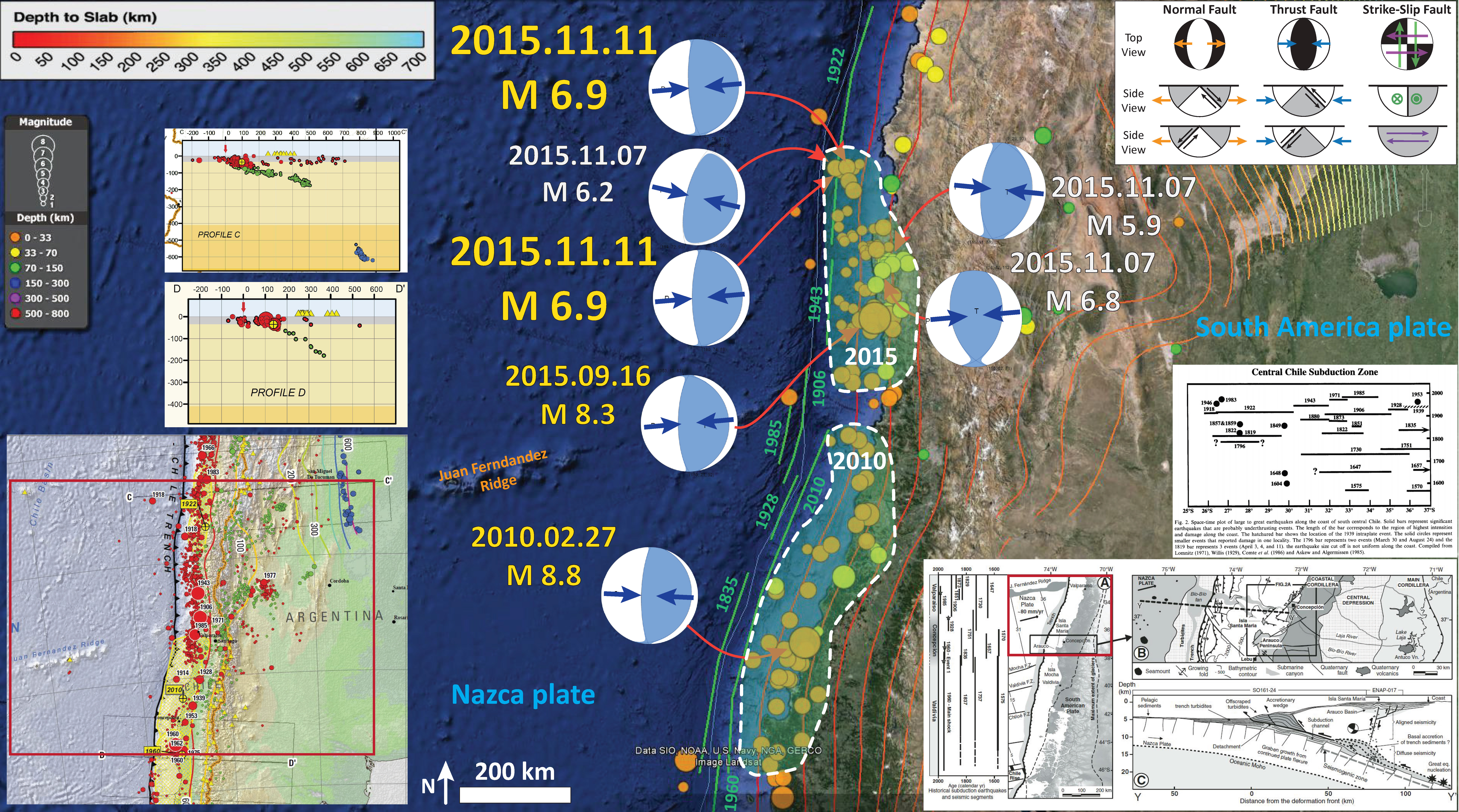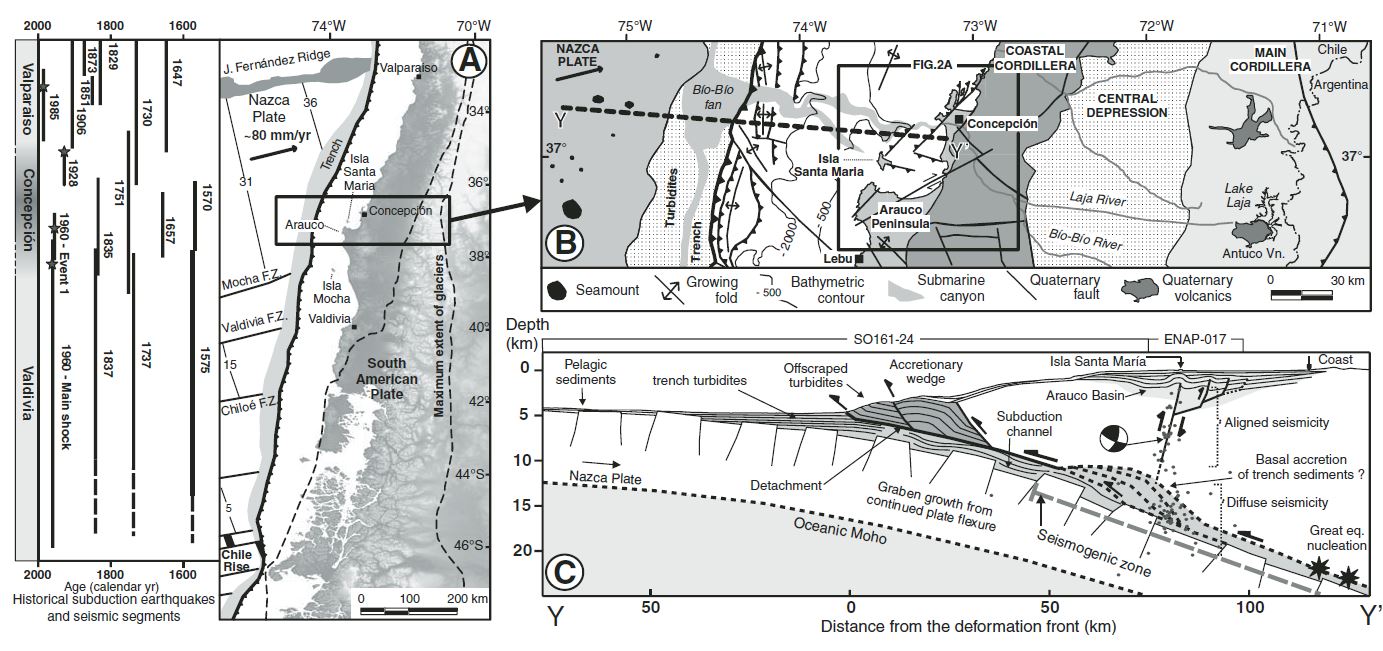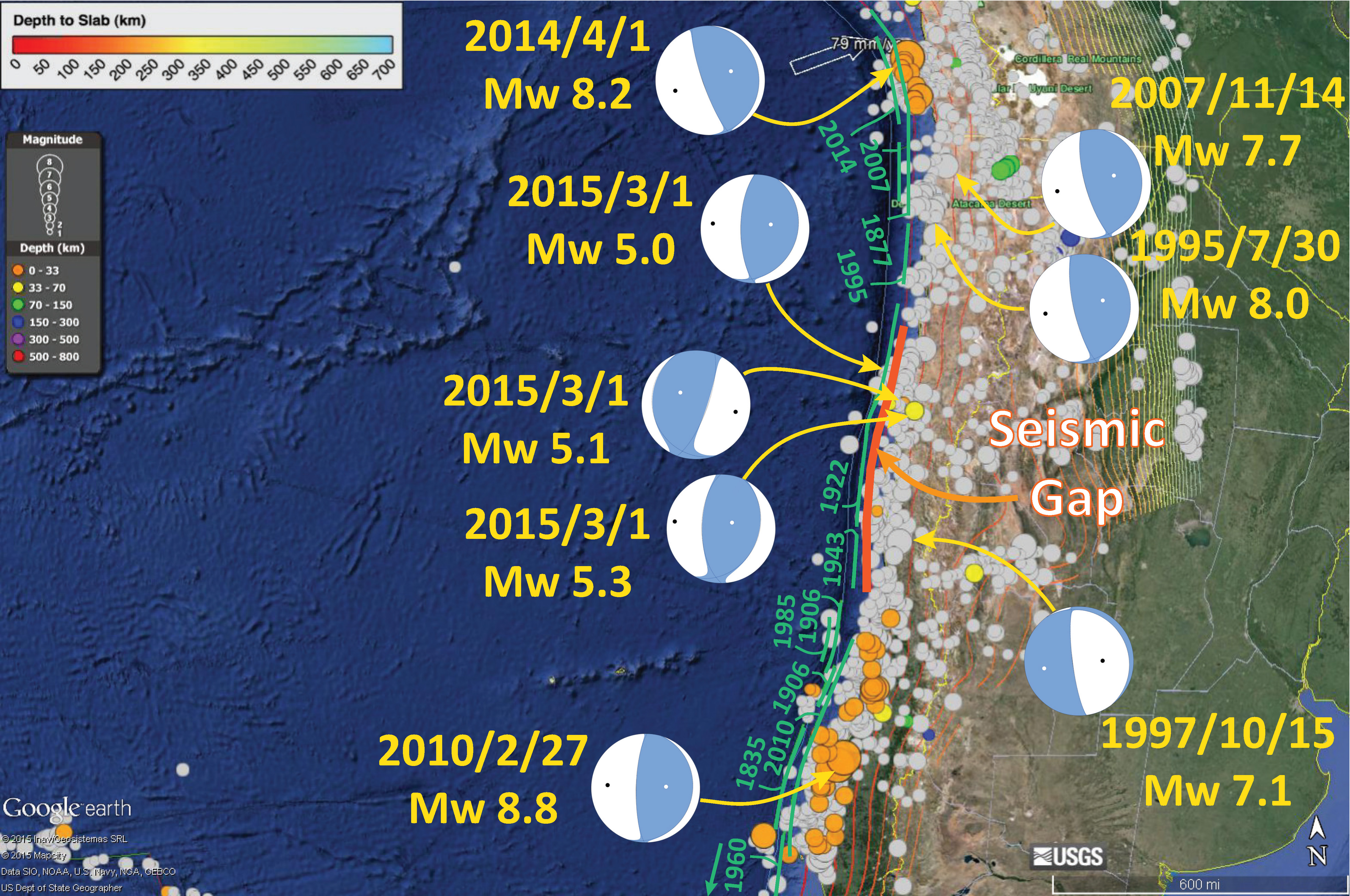The patch of the Chile subduction zone that ruptured in September 2015 continues to have large magnitude aftershocks. Today (2015.11.11) there were two M = 6.9 earthquakes in the northern part of this region. Four days ago (2015.11.07) there was another flurry of seismic activity, with the largest earthquake with a magnitude M = 6.8.
-
Here are the largest magnitude earthquakes from this past week:
- 2015.09.16 M 8.3
- 2015.11.07 M 6.2
- 2015.11.07 M 6.8
- 2015.11.07 M 5.9
- 2015.11.11 M 6.9
- 2015.11.11 M 6.9
I reported about the earthquakes from four days ago (2015.11.07) here. In that report, I discuss the differences between modeled ground motions and shaking intensities estimated based upon real observations.
Below is a map showing the seismicity of the past month with magnitudes greater than M 2.5, along with earthquakes from 2000-2015 with magnitudes greater than M 6.0. Here is the query that I used for the 2000-2015 epicenters. I placed the moment tensors for the largest earthquakes listed above, in addition to the moment tensor from the 2010 M 8.8 earthquake. I outline the region that slipped in 2010 and 2015 (so far) as dashed white polygons. I also plot the slab depth contours, which are contours that show where Hayes et al. (2012) estimate that the subduction fault is. Read more about their methods here.
I placed a moment tensor / focal mechanism legend in the upper right corner of the map. There is more material from the USGS web sites about moment tensors and focal mechanisms (the beach ball symbols). Both moment tensors and focal mechanisms are solutions to seismologic data that reveal two possible interpretations for fault orientation and sense of motion. One must use other information, like the regional tectonics, to interpret which of the two possibilities is more likely.

I also placed a map from the USGS earthquake summary poster in the lower left corner (Hayes et al., 2015). The red rectangle shows the general location of the main map. The USGS plot epicenters for historic earthquakes on the map, along with the slab contours (Hayes et al., 2012). There are two cross sections plotted on the map (C-C’ on the north and D-D’ on the south). The USGS plot these hypocenters along these two cross sections and I include those. The 2015 earthquake patch is just south of cross section C-C’.
In the lower right corner I place a cross section from Melnick et al. (2006). This shows the prehistoric earthquake history on the left and a cross section of the subduction zone on the right. This cross section is in the region of the 2010 subduction zone earthquake. Above the Melnick et al. (2006) figure I include the space-time diagram from Beck et al. (1998 ) showing the along strike length of prehistoric earthquakes in the central subduction zone. The map above shows these prehistoric rupture strike lengths as green lines (labeled with green labels). The 2015 earthquake series ruptured past the southern boundary of the 1943 earthquake and about 30% into the 1922 earthquake region. There is a small gap between the 2010 and 2015 earthquake series, which aligns with the Juan Fernandez Ridge (a fracture zone in the Nazca plate; von Huene et al., 1997; Rodrigo et al., 2014). This fracture zone appears to be a structural boundary to earthquake slip patches (subduction zone segmentation), at least for some earthquakes. Beck et al. (1998 ) show that possibly two earthquakes ruptured past this boundary (1730 A.D. and possibly 1647 A.D., though that is queried). This segment boundary appears to be rather persistent for the past ~500 years.
-
Here are some earthquake reports from this 2015 earthquake series:
- 2015.09.16 First Report
- 2015.09.16 First Update
- 2015.09.17 Second Update
- 2015.09.19 Third Update
- 2015.09.17 Tsunami Observations
- 2015.09.18 Historic Chile Tsunami Comparisons
- 2015.03.14 Seismicity 2000-2014
Here are some reports that include comparisons of historic seismicity of this region.
Here is the cross section of the subduction zone just to the south of this Sept/Nov 2015 swarm (Melnick et al., 2006). Below I include the text from the Melnick et al. (2006) figure caption as block text.

(A) Seismotectonic segments, rupture zones of historical subduction earthquakes, and main tectonic features of the south-central Andean convergent margin. Earthquakes were compiled from Lomnitz (1970, 2004), Kelleher (1972), Comte et al. (1986), Cifuentes (1989), Beck et al. (1998 ), and Campos et al. (2002). Nazca plate and trench are from Bangs and Cande (1997) and Tebbens and Cande (1997). Maximum extension of glaciers is from Rabassa and Clapperton (1990). F.Z.—fracture zone. (B) Regional morphotectonic units, Quaternary faults, and location of the study area. Trench and slope have been interpreted from multibeam bathymetry and seismic-reflection profiles (Reichert et al., 2002). (C) Profile of the offshore Chile margin at ~37°S, indicated by thick stippled line on the map and based on seismic-reflection profiles SO161-24 and ENAP-017. Integrated Seismological experiment in the Southern Andes (ISSA) local network seismicity (Bohm et al., 2002) is shown by dots; focal mechanism is from Bruhn (2003). Updip limit of seismogenic coupling zone from heat-fl ow measurements (Grevemeyer et al., 2003). Basal accretion of trench sediments from sandbox models (Lohrmann, 2002; Glodny et al., 2005). Convergence parameters from Somoza (1998 ).
In March 2015, there was some seismicity in this September/November 2015 earthquake slip region. I put together an earthquake report about those earthquake of magnitudes M = 5.0-5.3. I speculate that the 1922 earthquake region is a seismic gap. Note that this September/November 2015 earthquake region is along the southern portion of the seismic gap that I labeled on the map below. Dutchsinse can kiss my 4$$.
Here is a map that shows the recent swarm of ~M = 5 earthquakes. There are moment tensors for the earthquakes listed below, some recent historic subduction zone earthquakes. I placed the general along-strike distance for older historic earthquakes in green (and labeled their years). The largest earthquake ever recorded, the Mw = 9.5 Chile earthquake, had a slip patch that extends from the south of the map to just south of the 2010 earthquake swarm. The 2010 and 2014 earthquake swarm epicenters are plotted as colored circles, while most other historic earthquake epicenters are plotted as gray circles. Note how this March 2015 swarm is at the northern end of the 1922/11/11 M 8.3 earthquake. At the bottom of this page, I put a USGS graphic about what these moment tensor plots (beach balls) tell us about the earthquakes.

Hundreds of people died as a result of the 1922 earthquake. The USGS has more news reports about the 1922 earthquake here. There were also reports of a tsunami over 9 meters. So we know that this segment of the fault can produce large earthquakes and tsunami. However, it has been about a century since the last Great subduction zone earthquake in this region of the fault.
-
Here are the main earthquakes in the above map:
- 1922/11/7 M 7.0
- 1922/11/11 M 8.3
- 1995/07/30 M 8.0
- 1997/10/15 M 7.1
- 2007/11/14 M 7.7
- 2010/2/27 M 8.8
- 2014/4/1 M 8.2
-
There was significant subduction zone seismicity to the north of this region in 2014. I put together some material for the 2014 earthquake in the past. The page where I summarize some of my reports on the 2014 earthquake are found here.
- Interseismic Fault Coupling: the 2014 March Northern Chile Swarm 3/27/14: There were some earthquakes in this region of the subduction zone, so I started posting information about historic earthquakes there.
- M 8.2 earthquake in northern Chile 4/1/14: Here is the main page. There are a couple excellent animations from IRIS on this page!!!
- Tsunamis in the region of the M 8.2 northern Chile earthquake 4/1/14
- M 8.2 northern Chile tsunamis recorded at tide gages 4/2/14
- large magnitude aftershock in northern Chile 4/2/14: the second patch that slipped
- all right, another M 6.2 aftershock in Chile 4/2/14: another large aftershock in the 2014 swarm
- northern Chile M 8.2 earthquake series animations 4/3/14: I put this together to show how this swarm slipped two distinct patches (sub-faults in modeling parlance, asperities in Aki parlance)
- M 6.7 earthquake swarm in northern Chile! 2014/03/06: This is the swarm that started it all.
References:
- Beck, S., Barientos, S., Kausel, E., and Reyes, M., 1998. Source Characteristics of Historic Earthquakes along the Central Chile Subduction Zone in Journal of South American Earth Sciences, v. 11, no. 2., p. 115-129.
- Hayes, G.P., Wald, D.J., and Johnson, R.L., 2012. Slab1.0: A three-dimensional model of global subduction zone geometries in, J. Geophys. Res., 117, B01302, doi:10.1029/2011JB008524
- Hayes, G.P., Smoczyk, G.M., Benz, H.M., Villaseñor, Antonio, and Furlong, K.P., 2015. Seismicity of the Earth 1900–2013, Seismotectonics of South America (Nazca Plate Region): U.S. Geological Survey Open-File Report 2015–1031–E, 1 sheet, scale 1:14,000,000, http://dx.doi.org/10.3133/ofr20151031E.
- Melnick, D., Bookhagen, B., Echtler, H.P., and Strecker, M.R., 2006. Coastal deformation and great subduction earthquakes, Isla Santa María, Chile (37°S) in GSA Bulletin, v. 118, no. 11/12, p. 1463-1480.
- Rodrigo, C. and Lara, L.E., 2014. Plate tectonics and the origin of the Juan Fernández Ridge: analysis of bathymetry and magnetic patterns in Lat. Am. J. Aquat. Res, v. 42, no. 4, p. 907-917
- von Huene, R. et al., 1997. Tectonic control of the subducting Juan Fernandez Ridge on the Andean margin near Valparaiso, Chile in Tectonics, v. 16, no. 3, p. 474-488.

8 thoughts on “Earthquake Report: Chile in 2015!”